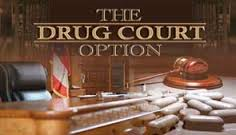NewDay Counseling
If you have a problem with alcohol or some other drug, call a NewDay counselor at 912.201.3605 * 401 Mall Blvd, Ste 101 D, Savannah, Ga * Free Phone Consultations
Drug Courts: National Results

Drug Courts have been around for a long time and the results have been very good. Most of us who’ve worked in the treatment field have known for a long time that jail has always exacerbated addiction, and that treatment of addiction is better for individuals and society. Drug Court as an alternation to jail is not a slam against the law and order position, it’s a practical position that has to do with the reality of addiction. In treatment, addicts aren’t escaping responsibility for their actions, they’re treated for a chronic brain disease for which they have to take responsibility. Addicts in Drug Court are held accountable – they’re expected to follow the rules and achieve the goals set for them by the treatment team.
In jail, the addict would be around other addicts and criminals and would not receive treatment for the condition that will likely keep the person in and out the court systems until something really bad happens. Below are facts about Drug Courts:
+ Drug Courts Reduce Crime
- FACT: Nationwide, 75% of Drug Court graduates remain arrest-free at least two years after leaving the program.
- FACT: Rigorous studies examining long-term outcomes of individual Drug Courts have found that reductions in crime last at least 3 years and can endure for over 14 years.
- FACT: The most rigorous and conservative scientific “meta-analyses” have all concluded that Drug Courts significantly reduce crime as much as 45 percent more than other sentencing options.
+ Drug Courts Save Money
- FACT: Nationwide, for every $1.00 invested in Drug Court, taxpayers save as much as $3.36 in avoided criminal justice costs alone.
- FACT: When considering other cost offsets such as savings from reduced victimization and healthcare service utilization, studies have shown benefits range up to $27 for every $1 invested.
- FACT: Drug Courts produce cost savings ranging from $3,000 to $13,000 per client. These cost savings reflect reduced prison costs, reduced revolving-door arrests and trials, and reduced victimization.
- FACT: In 2007, for every Federal dollar invested in Drug Court, $9.00 was leveraged in state funding.
+ Drug Courts Ensure Compliance
- FACT: Unless substance abusing/addicted offenders are regularly supervised by a judge and held accountable, 70% drop out of treatment prematurely.
- FACT: Drug Courts provide more comprehensive and closer supervision than other community-based supervision programs.
- FACT: Drug Courts are six times more likely to keep offenders in treatment long enough for them to get better.
+ Drug Courts Combat meth addiction
- FACT: For methamphetamine-addicted people, Drug Courts increase treatment program graduation rates by nearly 80%.
- FACT: When compared to eight other programs, Drug Courts quadrupled the length of abstinence from methamphetamine.
- FACT: Drug Courts reduce methamphetamine use by more than 50% compared to outpatient treatment alone.
+ Drug Courts Restore Families
-
FACT: Parents in Family Drug Court are twice as likely to go to treatment and complete it.
-
FACT: Children of Family Drug Court participants spend significantly less time in out-of-home placements such as foster care.
-
FACT: Family re-unification rates are 50% higher for Family Drug Court participants.
Recent Comments